Related Research Articles

A mural is any piece of graphic artwork that is painted or applied directly to a wall, ceiling or other permanent substrate. Mural techniques include fresco, mosaic, graffiti and marouflage.

A mimeograph machine is a low-cost duplicating machine that works by forcing ink through a stencil onto paper. The process is called mimeography, and a copy made by the process is a mimeograph.

Screen printing is a printing technique where a mesh is used to transfer ink onto a substrate, except in areas made impermeable to the ink by a blocking stencil. A blade or squeegee is moved across the screen to fill the open mesh apertures with ink, and a reverse stroke then causes the screen to touch the substrate momentarily along a line of contact. This causes the ink to wet the substrate and be pulled out of the mesh apertures as the screen springs back after the blade has passed. One colour is printed at a time, so several screens can be used to produce a multi-coloured image or design.
Surrealism in art, poetry, and literature uses numerous techniques and games to provide inspiration. Many of these are said to free imagination by producing a creative process free of conscious control. The importance of the unconscious as a source of inspiration is central to the nature of surrealism.

Cave paintings are a type of parietal art, found on the wall or ceilings of caves. The term usually implies prehistoric origin, and the oldest known are more than 40,000 years old, found in the caves in the district of Maros. The oldest are often constructed from hand stencils and simple geometric shapes. However, more recently, in 2021, cave art of a pig found in an Indonesian island, and dated to over 45,500 years ago, has been reported.
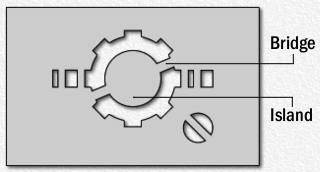
Stencilling produces an image or pattern by applying pigment to a surface under an intermediate object with designed gaps in it which create the pattern or image by only allowing the pigment to reach some parts of the surface. The stencil is both the resulting image or pattern and the intermediate object; the context in which stencil is used makes clear which meaning is intended. In practice, the (object) stencil is usually a thin sheet of material, such as paper, plastic, wood or metal, with letters or a design cut from it, used to produce the letters or design on an underlying surface by applying pigment through the cut-out holes in the material.
Aerography may refer to:

Banksy is a pseudonymous England-based street artist, political activist and film director whose real name and identity remain unconfirmed and the subject of speculation. Active since the 1990s, his satirical street art and subversive epigrams combine dark humour with graffiti executed in a distinctive stenciling technique. His works of political and social commentary have appeared on streets, walls and bridges throughout the world. Banksy's work grew out of the Bristol underground scene, which involved collaborations between artists and musicians. Banksy says that he was inspired by 3D, a graffiti artist and founding member of the musical group Massive Attack.
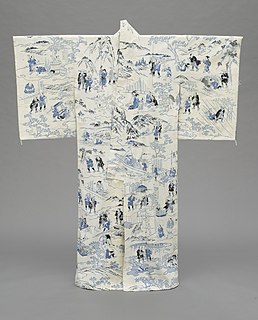
Katazome (型染め) is a Japanese method of dyeing fabrics using a resist paste applied through a stencil, typically a rice flour mixture applied with a brush or a tool such as a palette knife. Unlike yūzen, stencils are used repeatedly to make a repeating pattern. Pigment is added by hand-painting, immersion dyeing, or both. The area of the fabric covered and permeated by the paste mixture resists the later application of dye, thus creating undyed areas within the fabric.
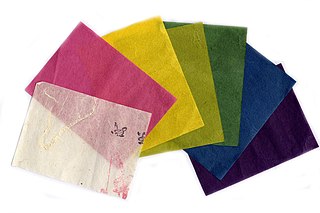
Washi (和紙) is traditional Japanese paper. The term is used to describe paper that uses local fiber, processed by hand and made in the traditional manner. Washi is made using fibers from the inner bark of the gampi tree, the mitsumata shrub, or the paper mulberry (kōzo) bush. As a Japanese craft, it is registered as a UNESCO intangible cultural heritage.

Aerosol paint is paint that comes in a sealed, pressurized container and is released in an aerosol spray when a valve button is depressed. Aerosol painting is one form of spray painting; it leaves a smooth, even coat, unlike many traditional rolled and brushed paints. Standard-sized cans are lightweight, portable, inexpensive, and easy to store. Aerosol primer can be applied directly to bare metal and many plastics.

Transfer printing is a method of decorating pottery or other materials using an engraved copper or steel plate from which a monochrome print on paper is taken which is then transferred by pressing onto the ceramic piece. Pottery decorated using the technique is known as transferware or transfer ware.
Monoprinting is a type of printmaking where the intent is to make unique prints, that may explore an image serially. Other methods of printmaking create editioned multiples, the monoprint is editioned as 1 of 1. There are many techniques of mono-printing, in particular the monotype. Printmaking techniques which can be used to make mono-prints include lithography, woodcut, and etching.

A floorcloth, or floor-cloth, is a household furnishing used for warmth, decoration, or to protect expensive carpets. They were primarily produced and used from the early 18th to the early 20th century and were also referred to as oilcloth, wax cloths, and painted canvas. Some still use floorcloths as a customizable alternative to rugs, and some artists have elected to use floorcloths as a medium of expression. Most modern floorcloths are made of heavy, unstretched canvas with two or more coats of gesso. They are then painted and varnished to make them waterproof.
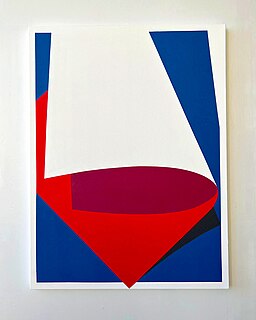
Tavar Zawacki formerly known as 'ABOVE' is an American abstract artist living and working in Lisbon, Portugal. For twenty years (1996–2016) Tavar Zawacki created and signed all of his artworks with his street artist pseudonym, 'ABOVE'. Tavar was born and raised in California until the age of 19, at which time, Zawacki bought a one-way flight from California to Paris, France, bringing with him a backpack full of art supplies, all the money in his bank account (US$1,500), and a 'rise above your fears' approach to starting his art career. Starting in Paris in 2000, Tavar transitioned from painting traditional letter style graffiti of A-B-O-V-E, to his 'Above arrow' icon that represented his optimistic mentality to 'rise above fears, challenges, and anything holding you back from your goals.' During a 20-year period, the artworks of ABOVE could be seen in over 100 cities spanning 50 countries around the world.
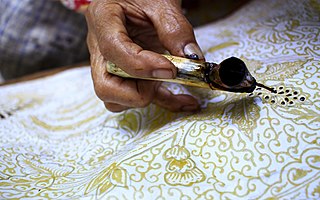
Resist dyeing (resist-dyeing) is a traditional method of dyeing textiles with patterns. Methods are used to "resist" or prevent the dye from reaching all the cloth, thereby creating a pattern and ground. The most common forms use wax, some type of paste made from starch or mud, or a mechanical resist that manipulates the cloth such as tying or stitching. Another form of resist involves using a chemical agent in a specific type of dye that will repel another type of dye printed over the top. The best-known varieties today include tie-dye, batik, and ikat.

Blek le Rat is a French graffiti artist. He was one of the first graffiti artists in Paris, and has been described as the "Father of stencil graffiti".

The Logan Tabernacle is a tabernacle of The Church of Jesus Christ of Latter-day Saints and is located in Logan, Cache County, Utah. It is used regularly for church meetings, most often semi-annual stake conferences, seminary graduations, musical concerts, and lectures. The tabernacle welcomes visitors and is open for tours each summer from June to September. It is the site of many local celebrations, including the city's annual Summerfest Arts Faire held each June on the tabernacle grounds.

The caves in the Maros-Pangkep karst are situated in South Sulawesi, Indonesia, and contain paintings from the Paleolithic considered to be the earliest figurative art in the world, dated to at least 43,900 years ago.

Yūzen (友禅染) is a Japanese resist dyeing technique where dyes are applied inside outlines of dyed or undyed rice-paste resist, which may be drawn freehand or stencilled; the paste keeps the dye areas separated. Originating in the 17th century, the technique became popular as both a way of subverting sumptuary laws on dress fabrics, and also as a way to quickly produce kimono that appeared to be painted freehand with dyes. The technique was named after Miyazaki Yūzen, a 17th century fan painter who perfected the technique. Miyazaki Yūzen's fan designs became so popular that a book called the yūzen-hiinagata was published in 1688, showing similar patterns applied to kosode. A fashion for elaborate pictorial yūzen designs lasted until 1692.
References
- ↑ Dalby, Stewart (24 July 1999). "Collectors who are splashing out on the tiles". Guardian. Retrieved 30 September 2011.
- ↑ Naumann, Frances. "Conversion to Modernism". The Art of Painting in More than Two Dimensions: The Paintings, Drawings, Watercolors, Cliché Verre, and Airbrush Compositions of 1917-1919. Retrieved 30 September 2011.
- ↑ "Аэрография Киев. Художник Roma GRom. Роспись стен. Граффити". Archived from the original on 2018-08-15. Retrieved 2013-02-26.